Executing an effective marketing strategy is challenging for businesses — large and small. But for small businesses trying to add marketing to the many spinning plates they already have in motion, a few unique hurdles can be especially difficult to address.
Keep reading to see how we help our small business clients on Milk Street tackle 5 of the most common setbacks.
Small Business Marketing Setback #1: Lack of Strategic Planning
Everybody starts somewhere. For small business marketing, that means you’re still in the process of growing your business. Each day, you’re overloaded with decisions, task lists, and putting out the proverbial fire — or ten.
So it’s no surprise that when marketing comes to mind, slapping a few strategies down, running with them, and never looking back is all many small business owners can find time to do.
What can go wrong?
Without a strategic plan, marketing — if you can call it that — becomes a haphazard effort that simply creates noise. You’re putting a message out there that falls into the hands of people who are likely to be uninterested in what you have to offer.
You can easily waste time, resources, and money. And, worst of all, you might actually be creating a truly valuable product or service, but if the customers you want to connect with — and those that want to find you — don’t know you exist, your business is likely to fail.
How to dodge this setback
Before you even begin talking strategy plan, gather the essential components of your marketing puzzle:
- Your target audience. Who is your ideal customer? What pain points are they experiencing? What solutions are they craving? Where are they most likely to find you? What will a successful outcome look like for them?
- Your unique value proposition. What differentiates you from the competition? What can a customer expect from you that they can’t expect from your competition?
From here, you can move on to developing a targeted multi-channel campaign.
Small Business Marketing Setback #2: Skimping on Website Development
Your website is that one and only chance to make a first impression on potential customers. If those potential customers click away, it’s very likely you won’t get a second chance at them.
That first impression sets the tone and informs future web visits and engagement. A website establishes distinguishing qualities about your brand and indicates what type of expertise and professionalism a potential customer can expect.
In fact, 50% of consumers believe that website design is crucial to a business’s overall brand [1].
Most small businesses understand how important an online presence can be, but too often don’t take the time to create a website. And those who do create a website often miss the mark by assigning the task to someone without enough experience to effectively design and maintain the site.
What can go wrong?
There are so many ways mismanagement of web design can harm a business. We’ll touch on just two.
First, an unpolished appearance, generic content, or a frustrating user interface can permanently tarnish your reputation.
Small businesses with poorly designed websites lose a significant portion of potential business:
- 42% leave a website because of poor functionality. [1]
- 38.5% leave a website when they see outdated design. [2]
And because 38% of consumers carefully consider layout and navigational links as they evaluate a brand [1], putting an amateur design out there into the world can be a costly mistake.
Then there’s the administrative side of managing a website.
Again, lots of admin to manage a website. But a major setback for small businesses revolves around domain name.
A domain name is a copyrighted web address that directs users to your website. Domain names are mission-critical. But domain names are lost, stolen, or allowed to expire all the time.
When this happens, companies lose money, brand integrity takes a hit, and productivity tanks while the business spins wheels in a cumbersome process of getting back on track.
How to dodge this setback
Optimize Web Development for UX
Steve Jobs was well known for beginning any project with the customer in mind rather than focusing on the technology or the product.
The same should hold true when you think about designing your website.
Imagine how your ideal customer will find your site and then imagine that customer easily navigating your site, finding what they need, feeling totally understood, and ultimately having just an amazingly positive experience.
Begin with that image of a customer having the ultimate experience and use that image to drive every decision you make about website design.
- So what does that ideal user interface look like?
- List the process in stages. Put yourself in the customer’s shoes in each stage and identify opportunities to cultivate an amazing interface, one stage at a time.
- Continue to drill down from larger abstract ideas to smaller practical issues within each stage.
Seek Administrative Support to Properly Manage and Maintain Your Site
Again, domain name is just the one example we’re touching upon here. But here are a few tips:
- Choose your domain name carefully. Be intentional about it. Your domain name provides a first impression of your brand to site visitors. When done right, it can even boost SEO ranking.
- Protect your domain name. Register your domain and keep your login info organized. It might sound silly now, but give yourself a few years and it’s easy to lose track of passwords, credit card expirations, and domain expiration dates.
Small Business Marketing Setback #3: Dropping the ball on content development
It may be cliche to say “content is king”, but we’re saying it anyway because it’s so very true.
Content is the vehicle through which you engage your target audience. And that means consistently producing fresh content that delivers real value for potential customers and knowing exactly where and how to position that content.
But again, small business owners wear so many hats that content gets pushed to the back burner and often falls off the radar.
What can go wrong?
To efficiently and effectively leverage content, you’ll need a strategic approach.
Otherwise content creation can become a highly inefficient time suck that doesn’t even come close to achieving the desired result.
- If you haven’t properly researched your target audience, the content you spend so much time and money creating can fall into disinterested hands and mean absolutely nothing for your business.
- If you don’t truly understand where and how your target audience connects with content, you could overpay the wrong media outlets and see nothing in terms of ROI.
- If your content creation process is not efficient enough, by the time you publish it, readers may ignore it because it’s irrelevant.
- If your content doesn’t properly incorporate SEO — or if search engines find that you’re too focused on SEO — your target audience won’t find their way to your content.
- If you reach your target audience with the wrong voice, tone that’s too salesy, you can permanently damage your brand. Potential customers can and will see right through a chaotic, cheesy content approach that is overly salesly and disregards their true needs.
How to dodge this setback
Eventually you can drive all kinds of efficiency with evergreen content and templates, but begin with these three steps:
Publish the right content in the right places. This begins with a deep understanding of your marketing funnel. What does the buyer journey look like? Map out each step from potential customers becoming familiar with your brand all the way through when they actually make a purchase. Then meet them where they are with what they need.
Position your business as a thought leader. Differentiate your business from the competition by avoiding generic topics and points of view. Put your unique spin on everything you generate.
Get organized. Whether you decide to build out and train a marketing department or simply outsource content strategy to an experienced firm, delivering targeted content in a regular cadence enables readers to build trust with your brand.
Small Business Marketing Setback #4: Operating without a plan on social media
While a business’s website is a direct link with potential and repeat customers, social media is an excellent tool/vehicle to create and maintain brand awareness and audience engagement.
What can go wrong?
Without an informed strategic approach, rolling out a social media campaign can result in brand-crushing disaster.
Not only do small businesses risk drowning in a resource-draining ripcurrent, but potential customers may end up perceiving your business as out of touch or even incompetent.
Common mistakes that result in this kind of tragic outcome include:
- Creating posts for the sake of creating posts.
- Telling readers what they already know.
- Posting from too many disconnected points of view and voices.
- Jumping on the wrong trends or into irrelevant conversations.
- Not replying and engaging with customer posts in a timely manner.
How to dodge this setback
If your small business is like many others, it’s got a lot to prove. Social media can be the perfect place to prove how valuable your solutions are for your target audience. But to avoid the pitfalls we outlined above — and many more — you’ve got to put in the work.
No surprises there, right? So what kind of work are we talking about?
Develop content that educates in a way that resonates. Every time you think about designing a post, stay laser-focused on providing value for the audience. Let your audience know:
- You understand their pain points. At first, focus on always operating with a customer-centric approach as you design each post. Then, once you gather customer feedback, share a few customer spotlights that begin with a deep dive into what the customer had been struggling with.
- You have exactly what they’re looking for. To prove this point, you might share a product or service highlight video or infographic. When you have success stories, share them! Customer testimonials go a long way.
- You are a legitimate, organized, and dependable business. To demonstrate this to potential customers, you’ll want to show them rather than tell them. Accomplish this by posting on a consistent basis. Social media outcomes take time to materialize. All too often, small businesses become discouraged when results take time. Stay the course, post regularly, and in a consistent and recognizable way, and you’ll be glad you did.
Small Business Marketing Setback #5: Poor time management
Making the most of a finite resource like time is something everyone strives to achieve. For many small business owners, time management is a constant struggle.
You’ve likely been down the road of setting aside a few hours — or maybe even a few days to focus on improving time management skills and streamlining some of the many tasks you perform. But until operations are humming along smoothly, your business runs the risk of catastrophe should one of your engines break down.
What can go wrong?
On any given day, there’s your normal workload. And on many days, there are fires to put out.
When you’re lucky, those fires take an hour or two. When you’re unlucky, those fires grind everything else in your business to a halt.
Successful marketing hinges on committing to a proactive approach. To launch campaigns that actually produce results requires analytics and research so you can anticipate tomorrow’s needs today — before you spend time and money.
Proactive marketing doesn’t happen when you’re busy putting out fires. It just doesn’t.
The stress that comes from operating reactively and worrying about whether or not your marketing is on track can be overwhelming and cause a whole host of other problems inside and outside of your business.
How to dodge this setback
You can find general time management advice anywhere. So we’ll spare you that.
When working with our small business clients, we’ve noticed that the most successful outcomes happen when the businesses put the right tasks on the plate of the right person. Then, you design reasonable yet ambitious goals setting and accountability metrics.
The same is true when it comes to marketing. If you’re not living and breathing marketing strategies, your time is better spent doing what you do best and what gets you up in the morning. And go hire really good marketing people with a proven track record.
This might sound oversimplified, but when each person in your business focuses on what they do best, you can really cover your bases that way.
Spend Zero Minutes on Marketing Per Day with Help from Milk Street
On Milk Street, we help our clients build and maintain strong, organic followings that drive new business. Contact us to see what we can do for you.
Make the move to Milk Street Marketing. Your Business. Reimagined.
Sources:
[2] GoodFirms, 2021





